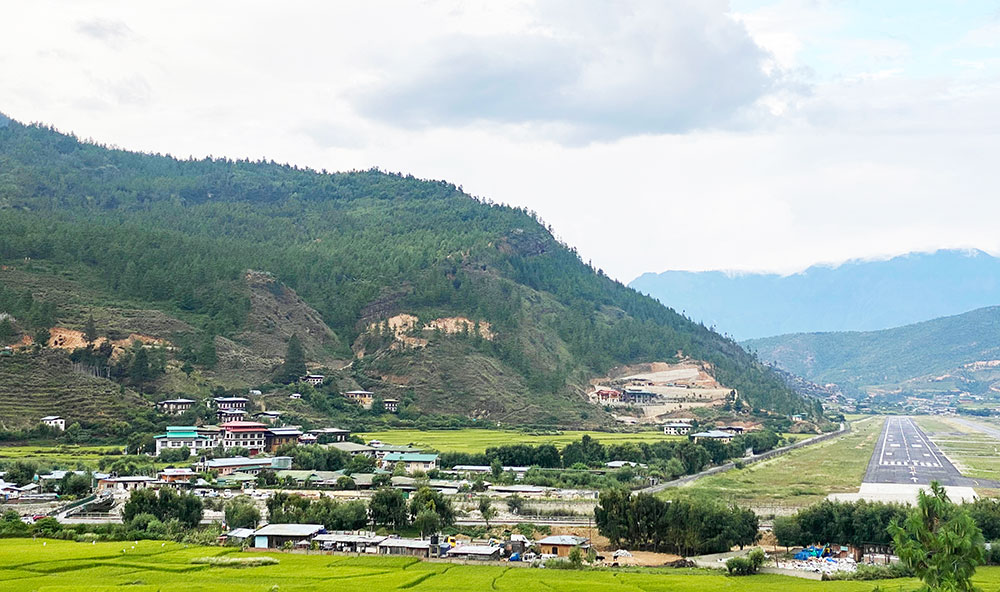Phub Dem
In recent times, some concrete structures have been mushrooming along Paro international airport stretch. While some have already constructed two-storey houses, others are told that their lands fall under no construction zone.
Those residing near airport premises have to seek construction clearance from Bhutan Civil Aviation Authority (BCAA). Approvals are given as per the flight funnel map that considers the safety and security of the airport and aircraft.
The colour-coded zoning maps show flight paths and standards of developmental activities such as heights of buildings and structures to ensure the safety of aircraft operations.
The map shows no construction zone, especially along the flight path. Further away from the flight path, the map shows a permitted area for the construction of one-storey house and then permitted sites for the construction of three-storey houses.
Considering the sloppy landscape of Paro, even if the lands are close by, those lands on slopes fall under no construction zones, while those below the pitch can build with its height levelling the hill. Further down towards Bonday and Pachhu, the elevation decreases, and the maps permit the construction of three-storey buildings.
The zones are prepared considering the landing and takeoff flight route as per the International Civil Aviation Organisation’s requirements and calculations.
According to the Chief of Air Navigation and Aerodrome, Sangay Wangdi, some houses are in no construction zones, but these houses existed before the map. He said that the department does not allow new constructions in these zones. “If we allow construction of houses in these areas, the airport will be unusable for landing and takeoff due to obstacles.”
Some houses which pose a high risk to flight paths are demolished. But some people reside illegally in one-storey homes in no construction zones.
Besides, he said that there are other structures for which the dzongkhag administration has given clearance without the knowledge of the department, adding that if these structures were to be demolished due to obstruction, the affected individuals would not get compensation.
While the map shows no construction along the Pelri Lhakhang area, the department only controls the flight funnel that includes takeoff and landing flight path areas towards the Bonday and Hotel Holiday Home.
For instance, he said that the department didn’t allow Hotel Holiday Home to put on the roof as it was found to be an obstacle and that land behind the hotel was not allowed for construction as it falls under the flight path.
The sides of the runway are called transitional slopes. Constructions along these slopes are reviewed and given permission based on many principles.
For instance, the new two-storey residential building behind the airport watchtower is allowed as the area lies behind the ridge.
Sangay Wangdi said that there was no way that the aircraft would go near the mountain. “The shielding principle guides the approval. The mountain already obstructs the area.”
However, he said that the construction of the commercial area right above the residential area was denied, considering the security of the runway.
The existing flight funnel map was designed in 2006. However, in 15 years, the airport has seen major developmental activities. The runway has also been extended from 1,800 metres to 2,260 metres.
With increasing air traffic, the airport will extend and exert pressure on the nearby area. Sonam Wangdi said that the department was making a new map in collaboration with the Ministry of Works and Human Settlement.
He said that the ‘no construction’ zone would further extend when the new maps come in. “We have been keeping provision for expansion and giving clearance as per the new changes happening in the airport.”
He said that BCAA was mandated to locate the flight path and brief about the hindrance of developmental activities. He said that land replacement and compensation of those affected individuals have to be routed through the dzongkhag administration. “We do not have the authority to give land replacement and compensation.”
If affected individuals want the BCAA’s support to explain it to dzongkhag and other agencies, he said the team was willing to help.
A landowner under anonymity said that he wanted to build a house but learnt that his land falls under no construction zone. He said that if land replacement is not processed sooner, there was no other way to construct homes in the no construction zone illegally.
In the meantime, Wangchang Gup Kuenzang Rinzin said that the gewog asked BCAA to take part in the survey for the new map, adding that gewog should know which land falls under the zones to make a list of the affected landholders. “The gewog will then call upon the affected individuals and seek land replacement altogether.”
He said that the gewog was awaiting the survey report and new map, and it will help process the land replacement of the affected landowners.
Edited by Jigme Wangchuk


